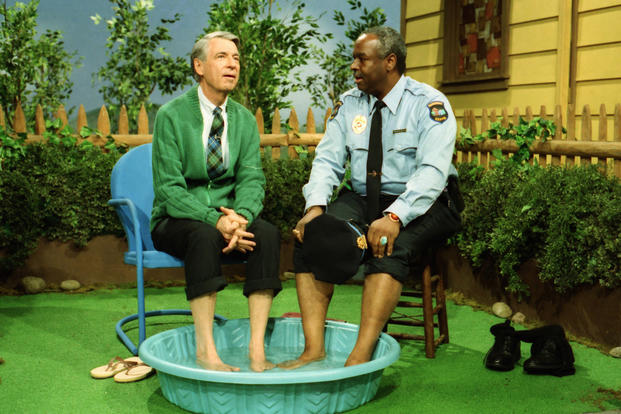A new documentary on Fred Rogers hit theatres nationwide in time for Father's Day and is just what our torn nation needs. Known to most of us as Mr. Rogers, Won't You Be My Neighbor? begins as the story of a sickly boy confined to his bed for days at a time. All alone, the boy invents imagery friends to keep him company and knights them the keepers of both his dreams and his fears.
The boy is depicted as an animated Daniel Tiger, the watch-wearing puppet that was also reportedly Rogers's alter ego. The film is not a biopic, and little is revealed about Rogers's past; it is rather an exploration and testament to a man who only wanted what he felt was best for children. Though he hated television for its depictions of violence, he saw it as the best way to reach as many children as possible.
The film is meant for adults, however, and suggests that maybe if we were to remember our childlike tendencies to not judge others, to be a little more like Mr. Rogers that we can start healing as a nation.
When Mr. Rogers' Neighborhood debuted in 1968, there was plenty of bloodshed just a click away for children to see, which the show addresses. A lifelong Republican, the children that let Mr. Rogers into their living rooms every day after school didn't care for whom he voted though he often broached political topics.
The show was only a few months in when Bobby Kennedy is assassinated on a campaign stump at the Ambassador Hotel. Speaking as most children do with no-filter honesty, Daniel Tiger says to Mr. Rogers, "That man killed that other man. I'd rather talk about it another day."
When Mr. Rogers gives Daniel Tiger all the time he needs to express his grief, it reminds audience members that we all grieve uniquely. He reminds us that it's okay to take our time. We're all different.
When footage of whites dumping harsh chemicals into segregated swimming pools hit the airwaves, Mr. Rogers responded by inviting Officer Clemmons (Francois Clemmons) to soak his tired feet in a kiddie pool on a hot summer day.

Clemmons was the first African-American to have a recurring role on a kid's show.
At the end of the segment, Mr. Rogers, an ordained minister, dries Officer Clemmons's feet taking on the role of the sinner Mary Magdalene who washed Jesus's feet. Mr. Rogers would often ask others to pray for him and when asked why, he stated that he couldn't think of anyone closer to God than a sick child.
When angry protests turned bloody on the streets of America in real life, King Friday the 13th built a wall of barbed wire around his castle in the Kingdom of Make-Believe in a statement of fear. The townspeople below sent messages of love attached to balloons and lofted them towards the castle. At first, the king orders the balloons shot down, but then he reads them and takes down the wall. Sound familiar?
In 1969 President Nixon moved to cut funding for public broadcasting, prompting Mr. Rogers to go before Congress and urge that the U.S. Senate Subcommittee on Communications keep supporting the format. Speaking succinctly and passionately, Mr. Rogers described the show to Sen. John O. Pastore, who said Rogers gave him "goosebumps."
"I am grateful for your goosebumps," said Mr. Rogers. He then recited the lyrics to a children's song he wrote about anger.
"I think it's wonderful, just wonderful," said Pastore. "It looks like you just earned your $20 million dollars."
The film's takeaway is that we can all try to be a little more Christian, a little more kind, a little more like Mr. Rogers. Gen X kids, take your fathers; millennials take each other; singletons, take a date. Everyone, take a hankie, you're going to need it.




